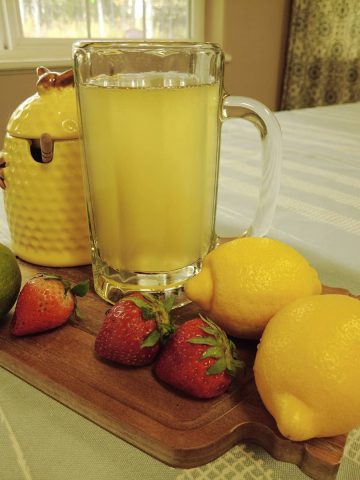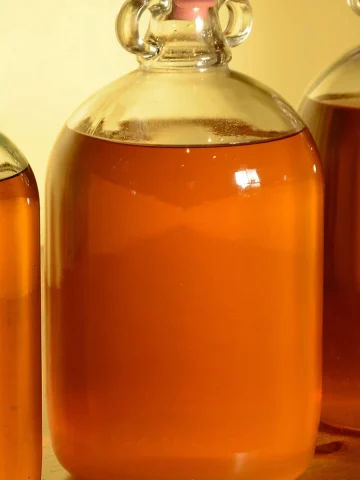What is a Campden Tablet?
Campden tablets are an ingredient that adds sulfites to a homebrewed wine, mead, or beer. There are multiple uses for Campden tablets in homebrewing.
One common use is to kill off harmful bacteria that may be present in the raw honey used in mead making.
The tablet will also prevent wild yeast from growing. Campden tablets will not kill the yeast but create an environment inhospitable to them.
A Campden tablet is a single pre-measured dose of potassium metabisulfite or sodium metabisulfite. The carrier element is the main difference between sodium (SMS) and potassium (KMS) metabisulfites.
Their effects are virtually the same, with sodium metabisulfite slightly more potent in contributing to SO2 gas. Most home mead or wine brewers will use sodium metabisulfite as an equipment sanitizer as it is cheaper.
I was first introduced to Campden tablets as a way to sanitize my home brewing equipment and remove the chlorine taste from my beer.
As I began to explore the wonderful worlds of cider and mead, Campden tablets became essential to guaranteeing a tasty final product.
What do Campden tablets do to a mead?
Campden tablets are a sanitizer to the honey and water mixture, also known as the “must.” Mead making depends on yeast being introduced to the must to begin fermentation.
However, this mixture can also be a breeding ground for mold, bacteria, or wild yeast strains with pungent flavors.
They are used to sanitize honey in a honey mead recipe. Add tablets one day before yeast.
When the Campden tablets are added to the must pre-fermentation, the sulfites interrupt the growing process of anything unwanted.
This allows the cultured yeast, resistant to the sulfites, to take over and start the fermentation process.
For best results, use high-quality wine or mead yeast.
The tablets don’t adversely affect the final flavor of the mead, as they add less than 75ppm of sulfur dioxide, well below what most people can detect.
Related Topic: How long does mead take to ferment?
Do you need a Campden tablet to make mead?
You don’t necessarily need to use Campden tablets to make mead, but it is highly recommended, especially for beginners.
There are so many variables that can affect the finished product that it is best not to take the chance without the tablets, and you will also likely get a longer shelf life out of your mead.
If you choose not to use the tablets, consider boiling the must mixture to help sterilize it.
- Re-sealable packaging
- Easy to Use
- Consistent results
Last update on 2025-05-19 / Affiliate links / Images from Amazon Product Advertising API
How to use Campden tablets in mead making?
When ready to try your hand at mead making, stir a crushed Campden tablet into the must. The tablets should be added one day before the cultured yeast.
How many Campden tablets do you add to a mead recipe?
Different recipes will call for different amounts of Campden tablets, but the most common ratio is one crushed tablet for every gallon or 8 pints of water.
No products found.
Use Campden tablets to sanitize homebrewing equipment:
Campden tablets can be used as a sanitizing solution. Crush up to four tablets into a quart of water.
Rinse the homebrewing tools with the solution or pour them into a fermentation container so a few inches of liquid cover the bottom.
Seal it, and the sulfur dioxide gas will fill the vessel and sanitize it within 30 minutes. The gas it produces is an effective sanitizer, usually used to sanitize fermenters and barrels.
Use Campden tablets to stabilize apple juice when making apple cider.
Campden tablets kill off wild yeast and bacteria from RAW apple juice. Use one crushed Campden tablet per gallon of apple juice, and dissolve the tablet in a little water or juice before mixing it into the entire amount of apple juice.
Allow 24 hours for the sulfur dioxide to off-gas before pitching yeast.
Use Campden tablets to remove chlorine and chloramine from brewing water.
Chlorine, a significant bleach component, is a common source of off-flavors in homebrewed beer. It contributes to chlorophenols, giving your beer an unpleasant medicinal flavor.
Some city water supplies use chlorine to make it safe to drink; others use chloramine. While you can boil chlorine out of the water, chloramine is harder to remove.
To remove chlorine and chloramine, add half of a crushed Campden tablet to 5 or 6 gallons of brewing water will break down chlorine into chloride, sulfate, and ammonia, which are beneficial to beer in small amounts. A few minutes is all it takes.
What is Mead?
It’s complex, fragrant, and sweet. Mead (also sometimes known as honey wine) is arguably the world’s oldest fermented beverage.
If you’ve drank your share of mead, making your brew may have crossed your mind.
While the process of making mead is not complicated (after all, our ancestors figured it out as early as 7000 BCE), some modern tricks will make your mead safer and keep it from spoiling.
Ready to Make Some Mead?
If you’re ready to start brewing (and enjoying!) your mead but were put off by Campden tablets, take heart!
Mead is one of the oldest and simplest fermentation products, and Campden tablets only make the process easier.
Adding just one tablet will help protect your mead from unwanted tastes and give you peace of mind knowing that your ingredients are sanitized.
Happy Mead Making!





